
The Stein Salon, in "Midnight in Paris"
"All our recent accessions are unfortunately by people you never heard of so there's no use trying to describe them, except that one of those out of the salon [the Matisse] made everybody laugh except a few who got mad about it and two other pictures are by a young Spaniard named Picasso whom I consider a genius of very great magnitude."
~ Leo Stein, 1905
Hello, it's Erika from small shop! Since "Midnight in Paris" is one of Paloma's favorite movies, I thought it would be fun to discuss that all-important artist hub in the film: Gertrude Stein's salon, and its significance in the development of Modern Art through the artists Matisse and Picasso.
Gertrude Stein was an American-born writer living in Jazz-Age Paris in the early 20th century. With her brother Leo, she began collecting inexpensive pieces by unknown artists, and eventually, their home became a center of creativity, critique and collaboration. The Steins' salon was the ONLY resource for avant-garde art at the time, and "Saturday Evenings" in their living room at 27 Rue de Fleurus became a tradition. And thank goodness — it is because of their patronage and their willingness to make their collection accessible that early modern art thrived. It's no wonder Woody Allen wanted to recreate such magical moments!
Let's brush up on the major players here and what they're known for.
* * *
CEZANNE = Post-Impressionism, 1886-1914
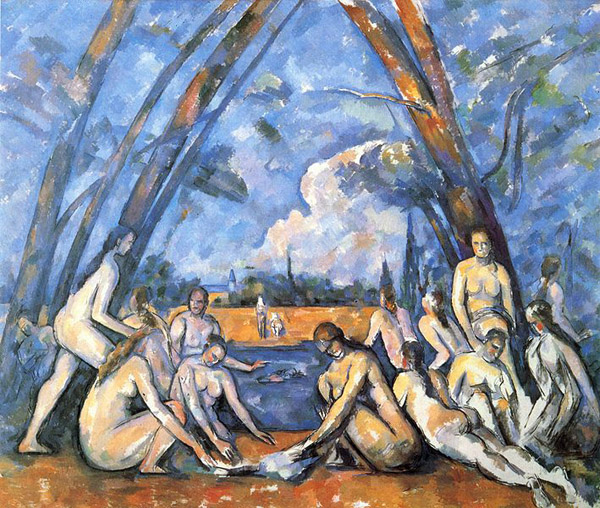
"The Bathers" by Cezanne, 1905
Paul Cézanne (from the previous period) would not have participated in person in Stein's salon, but pieces of his including "The Bathers" (above, considered a masterpiece of modern art) and "Portrait of Mme. Cézanne" were on display there. There is little doubt that his work heavily influenced both Matisse and Picasso who claimed Cézanne to be "the father of us all." Cézanne (and Post-Impressionist contemporaries Gauguin and Van Gogh) took Impressionism of the late 1800's to the next level by experimenting with flat areas of color and geometric shapes. These ideas were further developed into Cubism by Picasso, Braque and Gris.
* * *
MATISSE = Fauvism, 1900-1910 (in his early career)
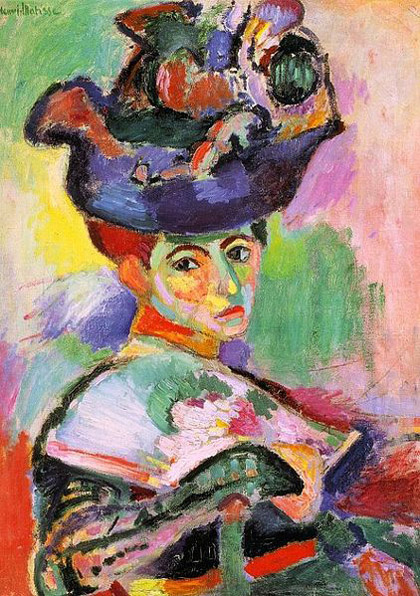
"Woman with a Hat" by Matisse, 1905
The Steins purchased an early work of Henri Matisse's, "The Woman with a Hat" (above), after an extremely poor reception at the 1905 Salon d'Automne. In the "Fauves" style (considered the first avant-garde movement), it was an important piece because like the rest of Matisse's career, he experimented with the use of unnatural color and simplification of forms. "Le Bonheur de Vivre" (below) was another acquisition of the Steins', one that cemented Matisse's place as a leader of a new school of painting.
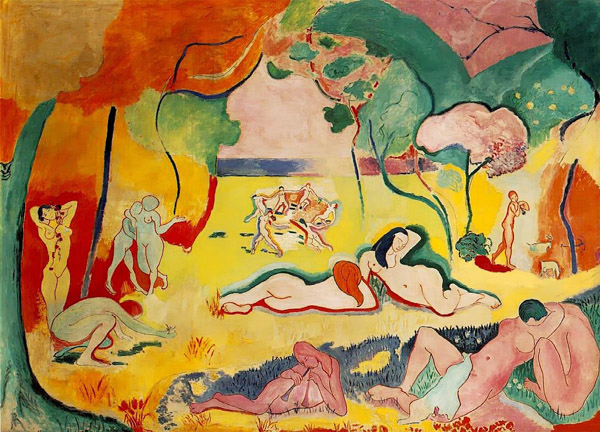
"Le Bonheur de Vivre" by Matisse, 1906
Gertrude's brother Michael and his wife Sarah became life-long patrons of Matisse, and eventually their apartment held the largest collection of his work outside of his own studio. Matisse enjoyed a long 50-year career in various media (later known for his collage "cutouts"), and is regarded as one of the founders of Modern Art.
* * *
PICASSO = Cubism, 1907-1918
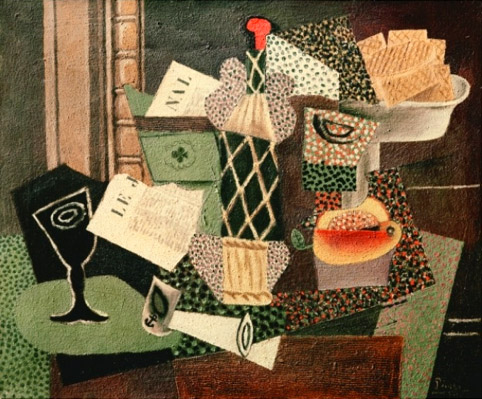
"Still Life with a Bottle of Rum" by Picasso, 1914
You know Picasso as the founder of Cubism. But he may not have been able to get to that point if it weren't for the unending support of Gertrude Stein throughout his entire career. It was at 27 Rue de Fleurus that he and Matisse (12 years his senior) met in 1905 and became life-long friends and rivals. The Steins owned over a hundred of his drawings, several watercolors as well, and would often bring friends by the salon to view and purchase Picasso works to support the artist. But it is because of Cézanne and Matisse before him, Picasso was able to take abstraction further to represent his subjects from multiple viewpoints, deconstructing and reconstructing them.
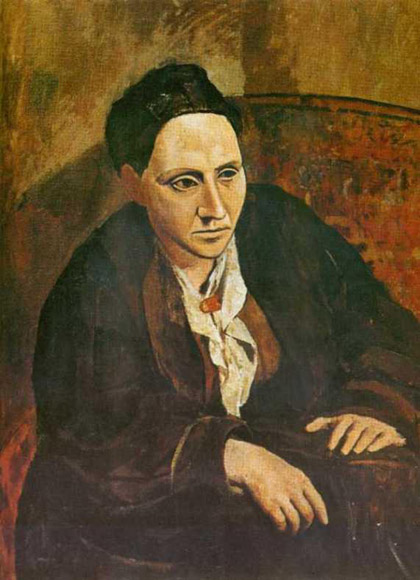
Portrait of Gertrude Stein by Picasso, 1906
It is often said that Gertrude Stein's own writing style can be described as "Cubist" as well, in its deconstruction of grammar, structure and syntax. I find it fascinating that she was able to translate a purely visual style into a literary one!
* * *
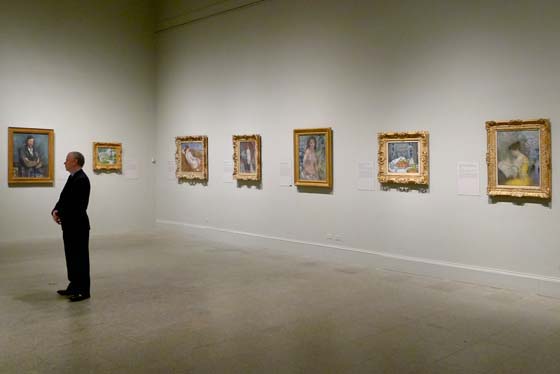
"The Steins Collect" at The Metropolitan Museum of Art
If you are fortunate enough to be in New York before June 3rd (I'll be there next week!), the Met has on display 200 works from the Steins' collection, focusing on Matisse and Picasso. I cannot wait — there is nothing like seeing art in context, and examining the progression and influences of styles!
Au revoir,

















































15 comments:
What an amazing post! Midnight in Paris recently catapulted itself to the top of my "favorite movies ever" list and it is because the art from this period is to DIE for!
I was sad to have missed the Stein collection when it was in SF (yes- almost made a trip all the way out there from Boston) but now that it is at the Met, I might have to consider a road trip.
thanks for featuring!
o0o0 how i love matisse! I studied abroad in florence for 4 months, and studied art. My days con sited on wandering cobblestone streets and visiting one museum after the next... o0o0 how this post made me miss those glorious days! Hugs from California! xx,
The Golden Girls
o0o0 how i love matisse! I studied abroad in florence for 4 months, and studied art. My days con sited on wandering cobblestone streets and visiting one museum after the next... o0o0 how this post made me miss those glorious days! Hugs from California! xx,
The Golden Girls
Erika a fabulous post. I love the movie because of all the artists integrated into the story line!! Great images!
2012 Artist Series featuring Theresa Cheek
xoxo
Karena
Art by Karena
ohhh loved this! great job on this post erika!
ohhh loved this! great job on this post erika!
Erika, I LOVED Midnight in Paris. Saw it in Paris the first time. It was magical :) Oh and if you need a date to go to the Met, I'm there!!! That's unless it's part of the Museum tour at Blogfest, in which case, I'm there anyway!! :)
That era is my favorite to read about... and I highly recommend "Art Lover: A Biography of Peggy Guggenheim" for folks who share my love for this period.
The movie was beautiful, but I wish the entire thing was about life in Paris back in the day!
This post educated me the most - although this period/these styles are lovely and I can certainly appreciate genius, they do not speak to me emotionally and I would not enjoy decorating around them. I also loved the movie and the characters, though, and am fascinated by Hemingway and all of those people living and sharing their creativity together. Awesome post!
xoxo -e (modern24seven)
Such a fun post today - and long! I've had the pleasure of browsing for over half an hour! Very cute!
I want to surround myself with Mattise!
Just wanted to let you know ow much I enjoyed this post. I am going to New York on June 7, unfortunately too late for being able to visit this exhibition. :-( I wish I could.
With the current controversy about Gertrude Stein and after the Edward Burns's answer it is interesting to Know one of the last Gertrude Stein's vew before dying when she speaks about art it is also politic .
Stein's preface to the exhibition by Francisco Riba Rovira at Roquepine Gallery in May 1945:
« It is inevitable that when we really need someone we find him. The person you need attracts you like a magnet. I returned to Paris, after these long years spent in the countryside and I needed a young painter, a young painter who would awaken me. Paris was magnificent, but where was the young painter? I looked everywhere: at my contemporaries and their followers. I walked a lot, I looked everywhere, in all the galleries, but the young painter was not there. Yes, I walk a lot, a lot at the edge of the Seine where we fish, where we paint, where we walk dogs (I am of those who walk their dogs). Not a single young painter!
One day, on the corner of a street, in one of these small streets in my district, I saw a man painting. I looked at him; at him and at his painting, as I always look at everybody who creates something I have an indefatigable curiosity to look and I was moved. Yes, a young painter!
We began to speak, because we speak easily, as easily as in country roads, in the small streets of the district. His story was the sad story of the young people of our time. A young Spaniard who studied in fine arts in Barcelona: civil war; exile; a concentration camp; escape. Gestapo, another prison, another escape... Eight lost years! If they were lost, who knows? And now a little misery, but all the same the painting. Why did I find that it was him the young painter, why? I visited his drawings, his painting: we speak.
I explained that for me, all modern painting is based on what Cézanne nearly made, instead of basing itself on what he almost managed to make. When he could not make a thing, he hijacked it and left it. He insisted on showing his incapacity: he spread his lack of success: showing what he could not do, became an obsession for him. People influenced by him were also obsessed by the things which they could not reach and they began the system of camouflage. It was natural to do so, even inevitable: that soon became an art, in peace and in war, and Matisse concealed and insisted at the same time on that Cézanne could not realize, and Picassoconcealed, played and tormented all these things.
The only one who wanted to insist on this problem, was Juan Gris. He persisted by deepening the things which Cézanne wanted to do, but it was too hard a task for him: it killed him.And now here we are, I find a young painter who does not follow the tendency to play with what Cézanne could not do, but who attacks any right the things which he tried to make, to create the objects which have to exist, for, and in themselves, and not in relation.
This young painter has his weaknesses and his strengths. His force will push him in this road. I am fascinated and that is why he is the young painter who I needed. He is Francisco Riba Rovira. »
Gertrude Stein
.
With the current controversy about Gertrude Stein and after the Edward Burns's answer it is interesting to Know one of the last Gertrude Stein's vew before dying when she speaks about art it is also politic .
Stein's preface to the exhibition by Francisco Riba Rovira at Roquepine Gallery in May 1945:
« It is inevitable that when we really need someone we find him. The person you need attracts you like a magnet. I returned to Paris, after these long years spent in the countryside and I needed a young painter, a young painter who would awaken me. Paris was magnificent, but where was the young painter? I looked everywhere: at my contemporaries and their followers. I walked a lot, I looked everywhere, in all the galleries, but the young painter was not there. Yes, I walk a lot, a lot at the edge of the Seine where we fish, where we paint, where we walk dogs (I am of those who walk their dogs). Not a single young painter!
One day, on the corner of a street, in one of these small streets in my district, I saw a man painting. I looked at him; at him and at his painting, as I always look at everybody who creates something I have an indefatigable curiosity to look and I was moved. Yes, a young painter!
We began to speak, because we speak easily, as easily as in country roads, in the small streets of the district. His story was the sad story of the young people of our time. A young Spaniard who studied in fine arts in Barcelona: civil war; exile; a concentration camp; escape. Gestapo, another prison, another escape... Eight lost years! If they were lost, who knows? And now a little misery, but all the same the painting. Why did I find that it was him the young painter, why? I visited his drawings, his painting: we speak.
I explained that for me, all modern painting is based on what Cézanne nearly made, instead of basing itself on what he almost managed to make. When he could not make a thing, he hijacked it and left it. He insisted on showing his incapacity: he spread his lack of success: showing what he could not do, became an obsession for him. People influenced by him were also obsessed by the things which they could not reach and they began the system of camouflage. It was natural to do so, even inevitable: that soon became an art, in peace and in war, and Matisse concealed and insisted at the same time on that Cézanne could not realize, and Picassoconcealed, played and tormented all these things.
The only one who wanted to insist on this problem, was Juan Gris. He persisted by deepening the things which Cézanne wanted to do, but it was too hard a task for him: it killed him.And now here we are, I find a young painter who does not follow the tendency to play with what Cézanne could not do, but who attacks any right the things which he tried to make, to create the objects which have to exist, for, and in themselves, and not in relation.
This young painter has his weaknesses and his strengths. His force will push him in this road. I am fascinated and that is why he is the young painter who I needed. He is Francisco Riba Rovira. »
Gertrude Stein
With the current controversy about Gertrude Stein and after the Edward Burns's answer it is interesting to Know one of the last Gertrude Stein's vew before dying when she speaks about art it is also politic .
Stein's preface to the exhibition by Francisco Riba Rovira at Roquepine Gallery in May 1945:
« It is inevitable that when we really need someone we find him. The person you need attracts you like a magnet. I returned to Paris, after these long years spent in the countryside and I needed a young painter, a young painter who would awaken me. Paris was magnificent, but where was the young painter? I looked everywhere: at my contemporaries and their followers. I walked a lot, I looked everywhere, in all the galleries, but the young painter was not there. Yes, I walk a lot, a lot at the edge of the Seine where we fish, where we paint, where we walk dogs (I am of those who walk their dogs). Not a single young painter!
One day, on the corner of a street, in one of these small streets in my district, I saw a man painting. I looked at him; at him and at his painting, as I always look at everybody who creates something I have an indefatigable curiosity to look and I was moved. Yes, a young painter!
We began to speak, because we speak easily, as easily as in country roads, in the small streets of the district. His story was the sad story of the young people of our time. A young Spaniard who studied in fine arts in Barcelona: civil war; exile; a concentration camp; escape. Gestapo, another prison, another escape... Eight lost years! If they were lost, who knows? And now a little misery, but all the same the painting. Why did I find that it was him the young painter, why? I visited his drawings, his painting: we speak.
I explained that for me, all modern painting is based on what Cézanne nearly made, instead of basing itself on what he almost managed to make. When he could not make a thing, he hijacked it and left it. He insisted on showing his incapacity: he spread his lack of success: showing what he could not do, became an obsession for him. People influenced by him were also obsessed by the things which they could not reach and they began the system of camouflage. It was natural to do so, even inevitable: that soon became an art, in peace and in war, and Matisse concealed and insisted at the same time on that Cézanne could not realize, and Picassoconcealed, played and tormented all these things.
The only one who wanted to insist on this problem, was Juan Gris. He persisted by deepening the things which Cézanne wanted to do, but it was too hard a task for him: it killed him.And now here we are, I find a young painter who does not follow the tendency to play with what Cézanne could not do, but who attacks any right the things which he tried to make, to create the objects which have to exist, for, and in themselves, and not in relation.
This young painter has his weaknesses and his strengths. His force will push him in this road. I am fascinated and that is why he is the young painter who I needed. He is Francisco Riba Rovira. »
Gertrude Stein
Post a Comment